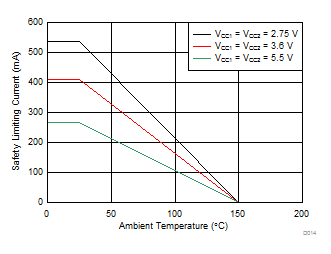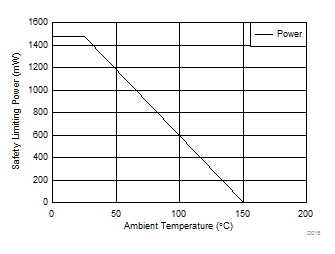ZHCSD31G November 2014 – July 2022 ISO7821
PRODUCTION DATA
- 1 特性
- 2 应用
- 3 说明
- 4 Revision History
- 5 Pin Configuration and Functions
-
6 Specifications
- 6.1 Absolute Maximum Ratings
- 6.2 ESD Ratings
- 6.3 Recommended Operating Conditions
- 6.4 Thermal Information
- 6.5 Power Dissipation Characteristics
- 6.6 Electrical Characteristics, 5 V
- 6.7 Electrical Characteristics, 3.3 V
- 6.8 Electrical Characteristics, 2.5 V
- 6.9 Switching Characteristics, 5 V
- 6.10 Switching Characteristics, 3.3 V
- 6.11 Switching Characteristics, 2.5 V
- 6.12 Typical Characteristics
- 7 Parameter Measurement Information
- 8 Detailed Description
- 9 Application and Implementation
- 10Layout
- 11Device and Documentation Support
- 12Mechanical, Packaging, and Orderable Information
封装选项
请参考 PDF 数据表获取器件具体的封装图。
机械数据 (封装 | 引脚)
- DWW|16
- DW|16
散热焊盘机械数据 (封装 | 引脚)
订购信息
8.3.1.2 Safety Limiting Values
Safety limiting intends to prevent potential damage to the isolation barrier upon failure of input or output circuitry. A failure of the I/O can allow low resistance to ground or the supply and, without current limiting, dissipate sufficient power to overheat the die and damage the isolation barrier potentially leading to secondary system failures.
| PARAMETER | TEST CONDITIONS | MIN | TYP | MAX | UNIT | |
|---|---|---|---|---|---|---|
| IS | Safety input, output, or supply current for DW-16 package and DWW-16 Packages | RθJA = 84.7°C/W, VI = 5.5 V, TJ = 150°C, TA = 25°C | 268 | mA | ||
| RθJA = 84.7°C/W, VI = 3.6 V, TJ = 150°C, TA = 25°C | 410 | |||||
| RθJA = 84.7°C/W, VI = 2.75 V, TJ = 150°C, TA = 25°C | 537 | |||||
| PS | Safety input, output, or total power | RθJA = 84.7°C/W, TJ = 150°C, TA = 25°C | 1476 | mW | ||
| TS | Maximum safety temperature | 150 | °C | |||
The maximum safety temperature is the maximum junction temperature specified for the device. The power dissipation and junction-to-air thermal impedance of the device installed in the application hardware determines the junction temperature. The assumed junction-to-air thermal resistance in the Section 6.4 is that of a device installed on a High-K test board for Leaded Surface Mount Packages. The power is the recommended maximum input voltage times the current. The junction temperature is then the ambient temperature plus the power times the junction-to-air thermal resistance.
 Figure 8-3 Thermal Derating Curve for Safety Limiting Current per VDE
Figure 8-3 Thermal Derating Curve for Safety Limiting Current per VDE Figure 8-4 Thermal Derating Curve for Safety Limiting Power per VDE
Figure 8-4 Thermal Derating Curve for Safety Limiting Power per VDE